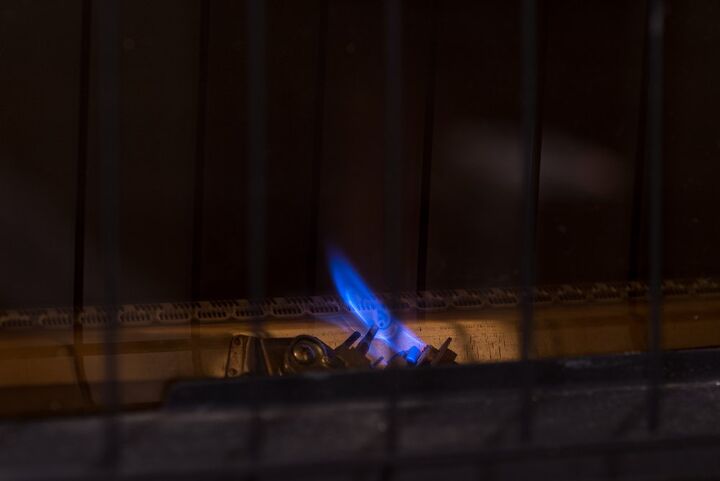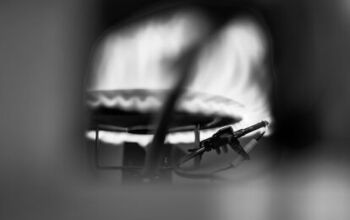Pilot Light Is Lit, But Furnace Won't Kick On

Nothing is more annoying in the HVAC world than when your furnace won’t kick on. It can also be intimidating at first because we all know that furnace problems sometimes lead to expensive repairs. So, what should you do when the pilot light is lit, but the furnace won’t kick on?
Check your thermocouple if the pilot light is lit, but the furnace won’t kick on. Replace your thermocouple for $100 if it’s covered with rust so that your furnace will work properly. Your furnace won’t kick on even if the pilot is lit if your burners are clogged, and you’ll need to clean them.
Sometimes, the solution is as simple as flipping the switch on your circuit breaker. You won’t likely need to replace your furnace as there are 5 easy solutions to this problem. Follow along as we explore what you should do when the pilot light is lit, but the furnace won’t kick on.
Why Is My Pilot Light On But No Heat?
Your pilot light could be on without your furnace kicking on if the thermocouple is bad or your thermostat is faulty. This could indicate problems with your wiring, gas valve, circuit breaker, or the furnace itself. Let’s take a look at the main causes and solutions for when your furnace won’t kick on even if your pilot light is lit.
No Contact With The Thermocouple
It is common for a furnace to fail to kick on if the pilot light is lit but the flame doesn’t touch the thermocouple. The thermocouple needs to recognize that the pilot light is lit to turn on the furnace. This is impossible if the pilot light can’t make contact with the thermocouple.
Sometimes, a thermocouple will jostle, and its position will shift. In that case, you can easily maneuver the thermocouple so that the pilot light’s flame will easily hit it. Your furnace also won’t kick on if the thermocouple is covered in a thick layer of rust.
Replace your thermocouple if it is caked with rust because it will struggle to recognize your pilot light. It generally costs at least $100 to replace the thermocouple for a furnace, but it’s worth the price.
Faulty Gas Valve
A faulty gas valve will hinder your furnace’s performance or keep it from starting at all. The only way to solve this problem is to replace the gas valve itself. This is necessary because you cannot repair a bad gas valve as the system won’t likely recognize it anymore.
However, the system will recognize a new gas valve if you install it properly. That way, your furnace will register every time the pilot light is lit, and it will kick on accordingly. It is recommended that you hire a professional to replace the gas valve on your furnace.
You can expect to spend $525 between parts and labor to replace a bad furnace gas valve, on average. It can cost as little as $300, however, and it ultimately comes down to labor rates. Otherwise, you can replace it yourself and save up to $200, but you should only attempt it if you have HVAC experience.
Bad Thermostat
Even your thermostat can keep the furnace from kicking on when the pilot light is lit. This can happen due to everything from debris and dead batteries to faulty wiring. Check the other functions of your thermostat before you do anything else.
For example, you can tell that the problem is with your furnace and not the thermostat if you can run the air conditioner. Otherwise, you should inspect and replace the batteries or take a look at the wiring so that you know if your thermostat is the problem. Even just dust within your thermostat can limit its function and your furnace may not start.
It’s worth it to hire an HVAC professional or electrician if the problem is due to faulty wiring. The wiring is everything when it comes to a thermostat, and the last thing that you want is to make the problem worse. It costs up to $200 or more to rewire a thermostat, but it’s worth it if it’s necessary, especially during the winter.
Furnace Is Turned Off
Sometimes, a furnace simply won’t kick on when the pilot light is lit because the furnace itself is turned off. The pilot light doesn’t require power because it relies on a gas valve and a flame. A furnace relies on power to turn on the burners, however, so it won’t kick if the power is turned off.
A circuit breaker can trip and shut off power to your circuit breaker in some cases. This can happen due to an electrical surge, a short, or a power outage. You can tell that this is the problem nearby electronics and appliances on the same circuit as your furnace is without power as well.
All that you need to do is flip the switch on your circuit breaker to restore power to your furnace. If that doesn’t work, then it may be a sign that your furnace’s electronics are shot, and you may need to replace the furnace altogether. That is likely the case if your furnace is up to 20 years old, and it costs an average of $6,000.
Burner Is Clogged
A clogged burner will make it nearly impossible for your furnace to kick on. It is a necessary part of healthy furnace maintenance to clean your burners as often as possible. This is an often overlooked step in furnace upkeep, but you should clean your burners every 1-2 years if not sooner.
Luckily, it’s easy to clean your furnace’s burners and remove soot and debris. You can reach the burners via an access panel that makes it easy to clean them. Always let your furnace cool down for up to an hour before you clean the burners to avoid burns.
Use a wire brush to penetrate the debris and remove it from your burners. While you’re at it, you can also clean the flame sensor near the burners if it is covered with debris. Your furnace should kick on when your pilot light is lit as long as these components aren’t dirty.
How Do I Know If My Furnace Flame Sensor Is Bad?
You can tell that your furnace’s flame sensor is bad if it is cracked. Over time, the flame sensor can wear out due to prolonged exposure to heat and rapid temperature changes. Another clear sign that your flame sensor is bad is that it is completely black at the end.
It is normal for the flame sensor to be slightly black, but it’s a bad sign if the end is pitch black. This can indicate that your burners have expelled a lot of soot and now the flame sensor is caked. You can avoid your flame sensor going bad if you continually clean it each time that you clean your furnace burners.
However, you will need to replace your furnace flame sensor if it’s too late and it’s already damaged. You can expect to spend as much as $200 to replace your flame sensor if you hire an HVAC professional.
Should The Pilot Light Always Be On In a Gas Furnace?
The pilot light should always be on in a gas furnace. This can cause your gas bill to be high for the month, but it can also ensure that you will have continuous heat. Many homeowners wait to turn their pilot light off until the fall or winter when temperatures drop.
Otherwise, you may waste a lot of money throughout the year on gas. Even still, natural gas is one of the less expensive energy resources, so it is worthwhile to leave your pilot light on constantly if you live in a cold climate. You can always easily turn off your pilot light if you simply turn the valve to the off position.
Summing It Up
Inspect the thermocouple for rust if the pilot light is lit but the furnace won’t kick on. Your thermocouple needs to recognize the pilot light’s flame or else the furnace won’t start. This can also happen if the flame doesn’t rise high enough to make contact with the thermocouple.
Inspect your gas valve and replace it if it is damaged or else your furnace may not have enough fuel to kick on. You can replace your furnace gas valve for $300-$500, and it’s worth it to hire an HVAC professional. Check your circuit breaker and flip the switch to restore power to the circuit that your furnace is on if it’s switched off.
Otherwise, you should check your furnace’s burners through the access panel. Clean them with a wire brush to unclog them so that your furnace will kick on when it recognizes the pilot light.
Related Guides

Nick Durante is a professional writer with a primary focus on home improvement. When he is not writing about home improvement or taking on projects around the house, he likes to read and create art. He is always looking towards the newest trends in home improvement.
More by Nick Durante



























